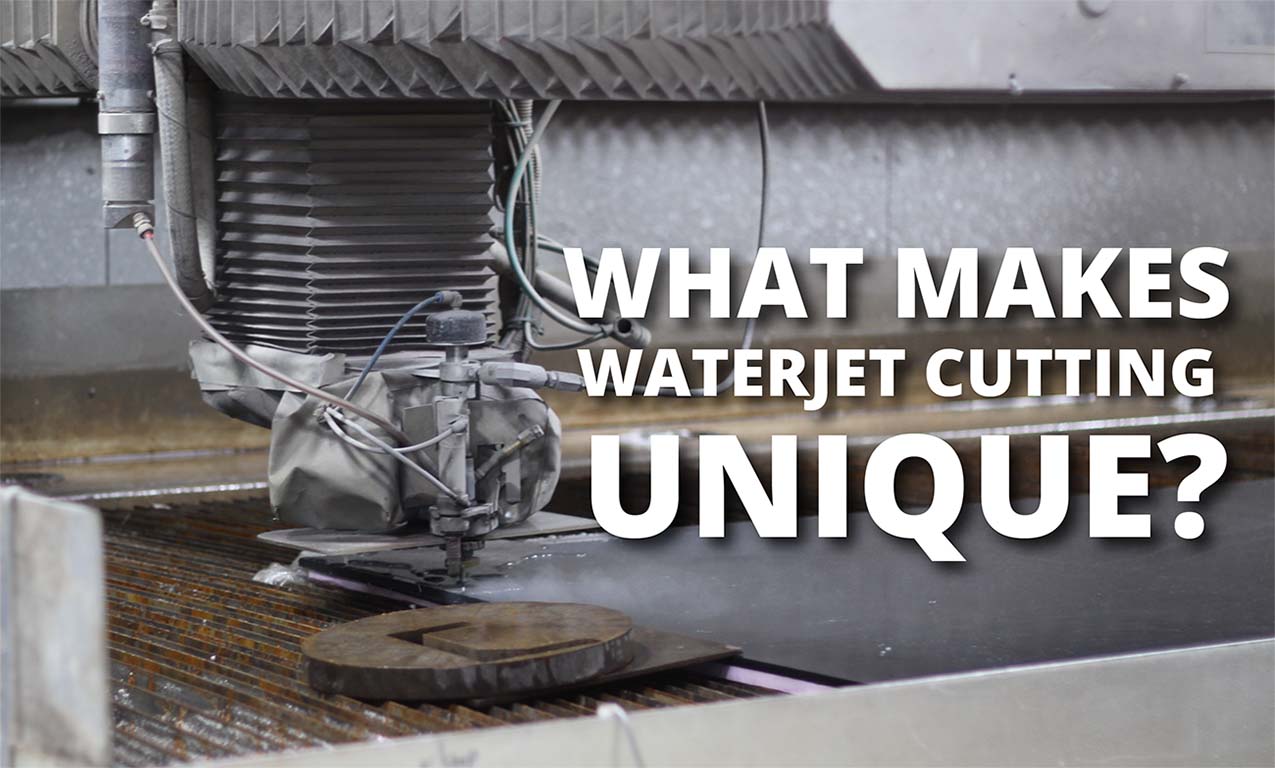

What Makes Waterjet Cutting Unique?
Overview of Waterjets
Waterjets have become increasingly flexible, fast, precise, and friendly to use. It uses tap water that is pressurized up to 60,000 psi and forced through a small hole called the “orifice” or “jewel.” When the water is mixed with garnet abrasive, a thin stream of water is formed moving at a rapid pace. This provides a smooth cut that does not require secondary processing.
There are two types of waterjets used in the cutting process. “Abrasivejet” is a subcategory of waterjet that uses abrasive to accelerate the cutting process. This technique can be used on materials ranging from rubbers to metals. “Purejet” or “water-only cutting” is another subcategory of waterjet that works without abrasive and uses only water to cut materials. This technique is better suited for softer materials, like foam or paper products. In other words, a waterjet is the machine, while abrasivejet and purejet are techniques employed by a waterjet. These two techniques make waterjets exceptionally versatile in material they are able to cut.
Comparison of Cutting Techniques
When utilizing cutting machinery, there are several options to explore before selecting the right solution for your cutting needs. Each technique has its pros, cons, and differences in price points, but it is essential to compare options in order to get the performance and end result you need. Here is a quick breakdown of why waterjet cutting is the most cost effective, high performance option for most of your cutting needs.
The most common cutting processes are waterjet, plasma, laser and electrical discharge machining (EDM). These processes can cut through materials like plastic, steel, stone, glass, tile, foam, rubber and many others.
Waterjet uses a process that utilizes a high speed liquid sandpaper to achieve a satin, smooth edge right from the table. This means less processing time with more precise results. Waterjet cutting is cost/time efficient, does not cause discoloration, and provides high tolerance, precise cuts.
Plasma utilizes a burning and melting technique with a high temperature ionized gas, producing a semi-smooth cut piece. This process requires a secondary processing involving slag grinding to remove the heat affected zone, eliminating heat distortion. While it is cost and time efficient, it does not offer multi-head cutting, and can leave burned edges.
Laser utilizes a melting technique involving a concentrated laser light beam. This process often requires a secondary process to remove the oxidized edge and HAZ (heat affected zone). Advantages of using the laser cutting method include its precision cutting, environmental friendliness, and time efficiency. However, laser cutting leaves discoloration of the material and it is not suitable for other machinery.
The electrical discharge machining (EDM) process uses an erosion technique, utilizing an electronic discharge that often does not require a secondary process to smooth edges. This process produces results similar to waterjet, but with rougher edges. Even though this process is similar to that of waterjets, it is not cost or time efficient, and it is extremely harmful to the environment due to the carbon buildup and toxic fumes released.
Materials and Thickness
Now that you know a little bit about the processing, let’s talk materials and thicknesses. Waterjet has the most capability, cutting virtually any material up to 24 inches in thickness. Waterjets are capable of tight tolerances up to .005 inch on materials up to 1” thick, even up to .001 tolerances are possible with some materials. This precision gives the waterjet the ability to cut intricate or delicate shapes that other cutting methods could not cut.
The plasma process primarily cuts steel, stainless steel, and aluminum up to 3 inches in thickness. Their accuracy is the lowest at .01 inch. Having a low accuracy makes the plasma process less ideal for projects that require precision and detail.
Laser cutting uses a variety of materials, but usually steel, stainless steel and aluminum of up to 1 inch in thickness. The tolerances for laser matches the waterjet ranging from .005 to .001 inch.
Finally, EDM cuts through conductive materials of up to 12 inches with tolerances matching .001 inch. This provides the closest precision and thickness compared to waterjets.
Each technique has different strengths, weaknesses and requirements for the specific performance your business requires. The waterjet process has the lowest price point, highest accuracy and smoothest edge to produce the widest range of applications while maintaining the integrity of the cut.

